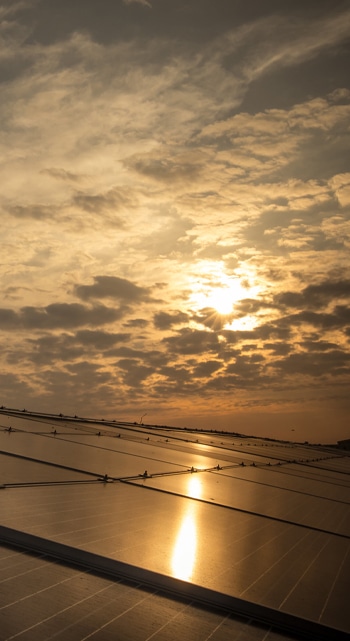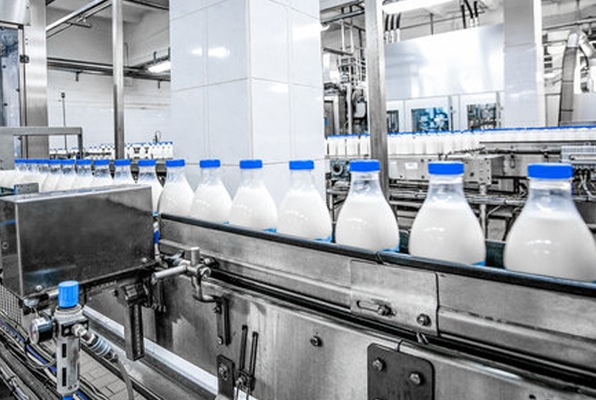Our country India, which has always been a rich agricultural country has been majorly successful in the dairy industry.During the financial year 2020-21, India exported 54,762.31 MT of dairy products to the globe, valuing Rs. 1,491.66 crores/ 201.37 million dollars.
The biggest export product being buttermilk.
India is the largest milk producer among all the countries. The country produces approximately 23% of global milk production. From 146.31 mn tonnes in 2014-15 to 209.96 mn tonnes in 2020-21, milk output in the country has expanded at a compound annual growth rate of roughly 6.2%. In the year 2021, the Indian citizen consumed about 83 million metric tons which is the major part of the total production. So, the market majorly caters the countrywide demand, whereas in the dairy export business, India is not even in the top 10 rankings.
The proportion of dairy products made with the raw milk gathered is shown in the table below:

The fluid milk and cream segment has the largest market share among other dairy products in the country. The Indian dairy industry is expected to grow at a CAGR of 2.5% from 2021 to 2027. The organized milk industry is expected to grow to 50% in 2025.
But the current trend of the market is price rise at a percentage of 14.3 in the year 2020.
Even though this results in a revenue growth of 13% in the same year, the local dairy industry and consistency of the product is being affected.
The government has projected to meet a demand of 180 million tonnes of milk by 2022. So, there is a huge scope for new processing units as the production and processing unit needs to grow by 5 million tonnes annually.
Components & Working Process of a Dairy Manufacturing Plant
On an average a 10,000 liters milk processing unit requires a land of approximately 2 acres with a handling capacity of 1,000 liters/day.
A basic processing farm should manufacture Toned Milk,Standard Milk, Cream and Ghee.
- Procurement of Raw Material: The main and the only raw material in this industry is milk. Naturally in India milk is collected from local villagers as only 10-12% of total milk output in the nation is now handled by the organized dairy sector (including cooperatives and private). The collected milk is brought to the facility in chilled container tanks. As the milk reaches the facility, further processing begins, where some steps are different to produce different dairy products.
Fluid Milk, Cream : After the procurement phase as the milk is delivered to the processing unit, milk generation is dependent on a number of different technologies and different machineries used.
The process through which the milk goes through are :
- Pasteurization: This method warms milk to 72°C for at least 15 seconds before cooling it quickly to kill any hazardous germs or microorganisms. This also enhances the shelf life of the product.
- Homogenisation: In this process milk is pushed under pressure through small nozzles, evenly scattering fat globules. This keeps the cream from separating and rising to the surface, giving it a more consistent texture and flavor. Some manufacturers make unhomogenized milk for individuals who like the cream to separate and rise to the top of the bottle.
Milk consistency can be improved using today’s farm technology, cow management, and industrial processes, and milk composition may be modified for year-round consistency. Milk composition is defined so that characteristics such as fat content are uniform regardless of the season or breed of cow from which the milk is derived.
The composition of the milk is monitored in the labs of the dairy processing unit to reach the International standard . These standards are consistent in every milk consuming country. Under this code the standard for packaged full-fat milk requires that it contain at least 3.2% of fat and 3.0% of protein.
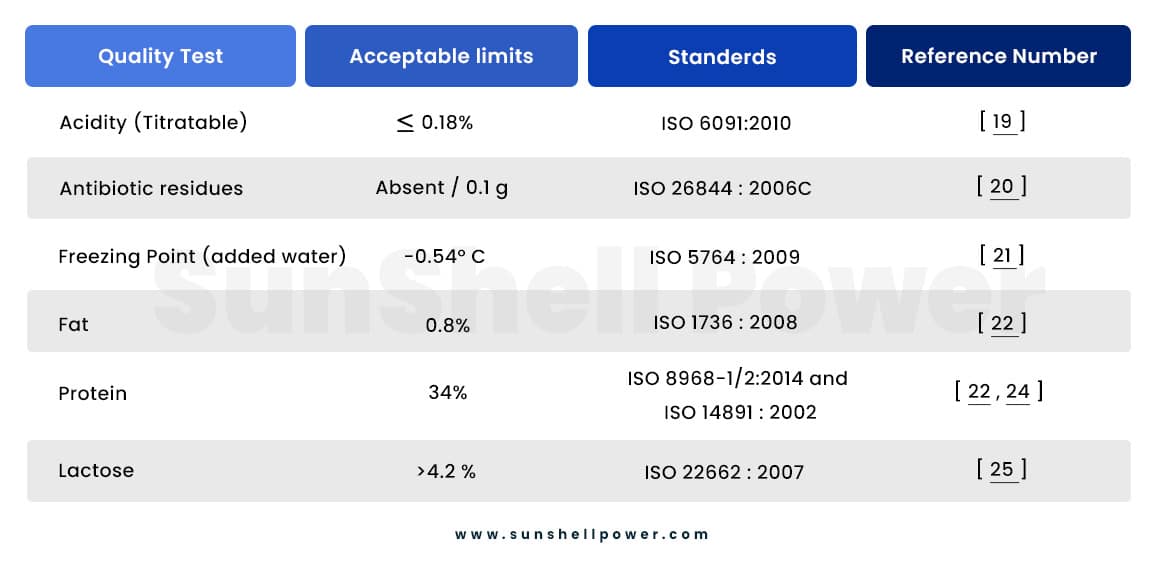
- Centrifugal Separation: To create low-fat, reduced-fat, or skim milk, part or all of the cream is removed. Skim milk solids can be added back in to improve the taste and texture while also providing additional nutrients like protein and calcium.
- Ultrafiltration: This transports milk over a membrane at a modest pressure, keeping protein, fat globules, and a considerable number of calcium complexes in check.
Water and lactose (milk sugar) pass through, leaving a high-protein, calcium-rich product behind. The fat content may be changed to fit the preferences of the consumer. - Reverse Osmosis: This is similar to ultrafiltration, except that the membrane traps the majority of the milk solids and only allows water to flow through. Lactose is still present in the finished product. There is no difference in flavor.
- Ultra Osmosis : It’s a hybrid of ultrafiltration and reverse osmosis that keeps milk solids out while allowing water and salt to pass through.
- Spray Drying: In this step the water from milk is removed to make powder milk. But the nutritional value of the raw milk is the same as in this powdered milk.
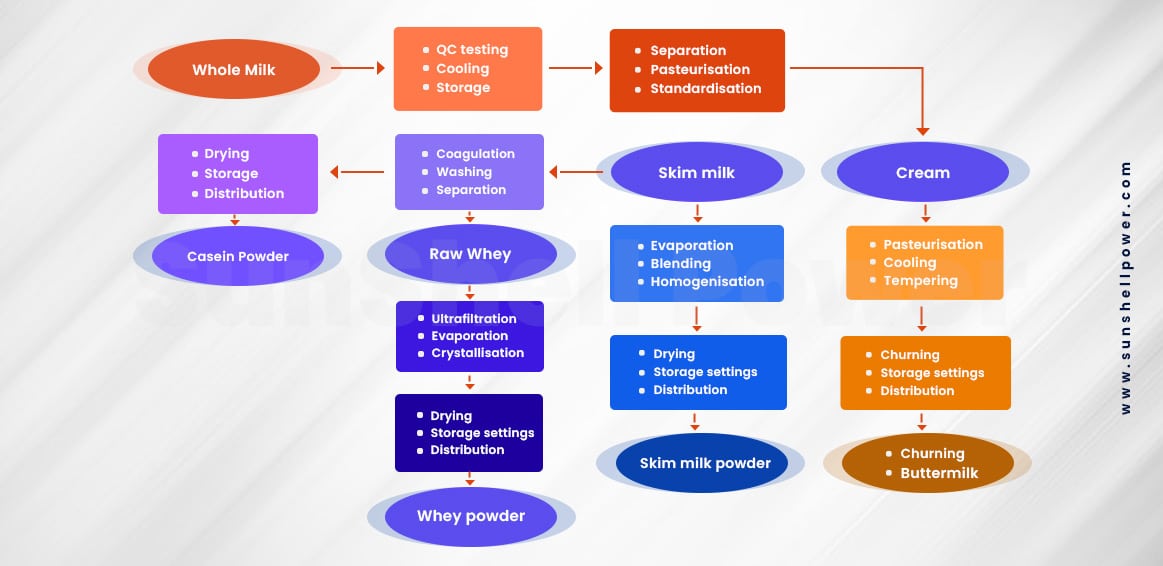
For this entire processing method, the following machineries are used:
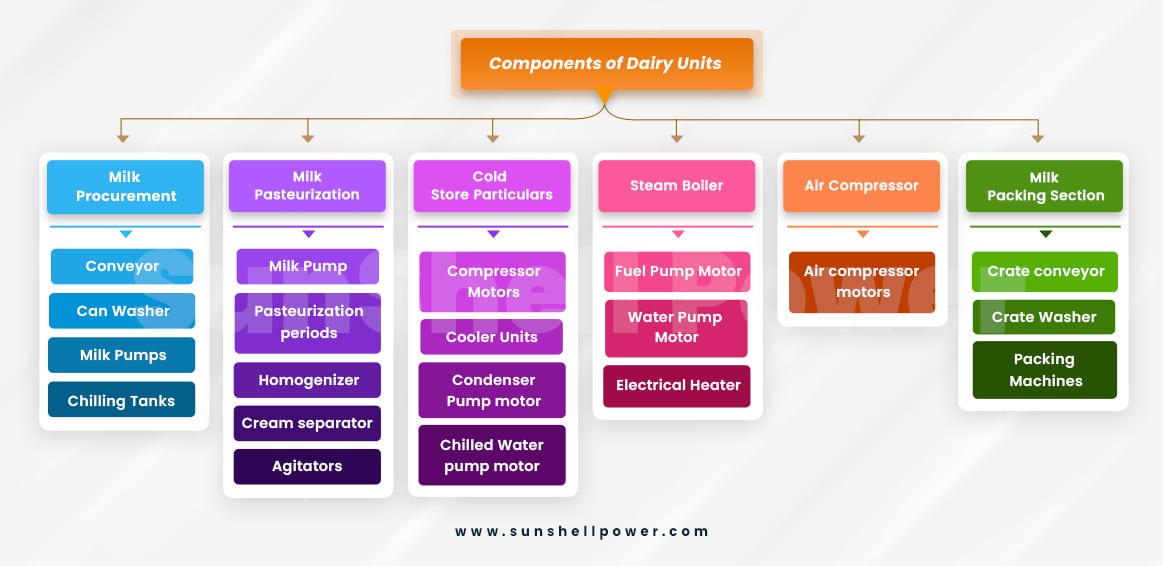
Electrical Load
The electrical load of a dairy product manufacturing plant depends on the various machines used in the pasteurization, packaging and crate washing. As there are a wide range of machines used in this sector, the exact load consumed by every machine is hard to identify.
The electrical energy consumption during the process of milk procurement, pasteurization, packaging and crate washing is around 137.49 , 288.78, 308.78 and 142.15 kWh respectively.
The major electricity usage in a dairy manufacturing farm is from running the motors of various machines, blowers and lighting in the premises.
The total average electrical load of the manufacturing unit is around 950kWh per day.
Power Backup
Majority of the dairy production units in India use diesel powered generators for reliable power. On an average such a facility with production capacity of 1000 liters/day will need a diesel generator of 800kW. Such a generator will have a fuel tank capacity of around 800-1000 gallon.
Problems faced by Dairy Manufacturing Plant
So, as the scenario suggests that the sector is highly profitable and viable, but it is not the case.
- Unreliable Power Leads Food Contamination: Every year the majority of the food loss and waste happens due to discontinuity between two processing steps during the dairy processing.
Approximately one-quarter of all dairy products are wasted during the manufacturing process. Premature microbiological spoilage of dairy products, such as fluid milk, cheese, and cultured goods, is a major source of dairy food waste.
Microbial contamination may occur at any stage along the manufacturing and processing chain and includes species such as gram-negative bacteria (e.g., Pseudomonas), gram-positive bacteria (e.g., Paenibacillus), and a variety of fungal organisms.
These microorganisms grow during the refrigerated stage. Due to unreliable power supply in the sector, these microorganisms grow at a rapid speed during this pause state and create various degradative enzymes that result in off-odors.
- More Diesel, More Cost: If stable electricity is to be delivered to the facility, diesel generators are the only options in these dairy farms. These diesel generators use much diesel further increasing the operational cost,
- Higher Tariff Charges : The big industrial consumers like steel factories, cement plants , dairy product processing plants draw a lot of power. As the tariff charges are rising day by day, the energy cost also rises accordingly.
- Huge Carbon, Massive Pollution: As the dairy sector is one of the largest electricity consuming sectors in the industry, the carbon free target, set by the sector is unlikely to be met.
So, What’s The Way Out? Solarizing Dairy Manufacturing Plant
Human civilization is increasingly moving toward renewable energy as technology advances. Solar power plants are also the most dependable renewable energy source. SunShell Power provides a solar rooftop solution for any steel mill challenge. Solar modules have a 25-year life expectancy and need no maintenance, making the plant a stable power source.
For dairy product manufacturing units we offer three types of rooftop solutions:
- Grid-connected Solar Rooftop Plant,
- Solar Street Light,
- Energy Efficiency
Grid-Connected Solar Rooftop Plant (On-Grid)
Grid-connected solar power plant with little maintenance and accessible net-metering capability, as well as a credit system based on power banking. This sort of power plant is excellent for establishments with a high demand and infrequent power outages.

Why On-Grid ?
Even though, in SunShell Power, every solar power plant is important and valuable for us, for dairy processing plants we would highly suggest the authority to install on-grid solar power plants. From our previous experiences, we have pointed out several points from which we have declared the Grid-connected plant to be a clear winner :
- These systems are ideally suited for very high power usage and for lowering energy expenditures.
- On-grid plants can be installed with or without net-metering,
- On-grid systems are very cost-effective and easy to install,
- As there is no battery backup in the system, there are less chances of battery failure and hence the maintenance is minimal which can be helpful in the busy environment of the processing unit.

Benefits of Installing Solar at Dairy Manufacturing Plant
Now, the question remains ,why should I invest in solar & what are the benefits that the other options can’t provide ?
Apart from being eco-friendly and producing green energy, solar power plants are a great financial and economical investment, which is also a reliable source of power. Here, from the feedback of our previous consumers we have listed overall benefits of solar,
- Reduced electricity bills as dependency on conventional electricity & DG is reduced
- Government gives subsidy for solar panels installations
- Tax benefits by going for accelerated depreciations
- Low maintenance and average life span of 25 years
- Environment friendly solar power plant is the best way to preserve and make the planet greener
- Proper utilization of the blank space on the roof shades
Average ROI
The average ROI of a grid-connected solar plant in a dairy processing unit is around 3.5-4.5 years, it can change based on the load of the facility.

Alternate Solutions
- Solar Street Lights: Usually the campus space is larger than regular fasciitis, proper illumination is required for safety and inspection purposes of the product. Solar street lights are the exactly right product for this purpose. We ,at SunShell Power, would suggest two types of solar street lights for the facilities.

- Two-in-one (Semi-integrated) : Used for a variety of purposes, these are easy to install and are low-maintenance.
- Solar Mini Mast: Best for places with unstable power sources. It uses green energy and needs almost negligible maintenance.
Energy Efficiency
As per to meet the required upcoming demand in the country and to scale the export business of this sector, energy efficiency and management of waste heat is equally important.
- Energy Audit : EA refers to the verification, monitoring, and analysis of energy usage, which includes the production of a technical report providing suggestions for increasing energy efficiency, as well as a cost-benefit analysis and an action plan to minimize energy use.
- Regenerator : Heating and cooling energy may be conserved by employing a regenerator, which uses the heat content of pasteurized milk to reheat the incoming cold milk.(Temperature rise due to regenerator)/(% regeneration) (total temp. increase)
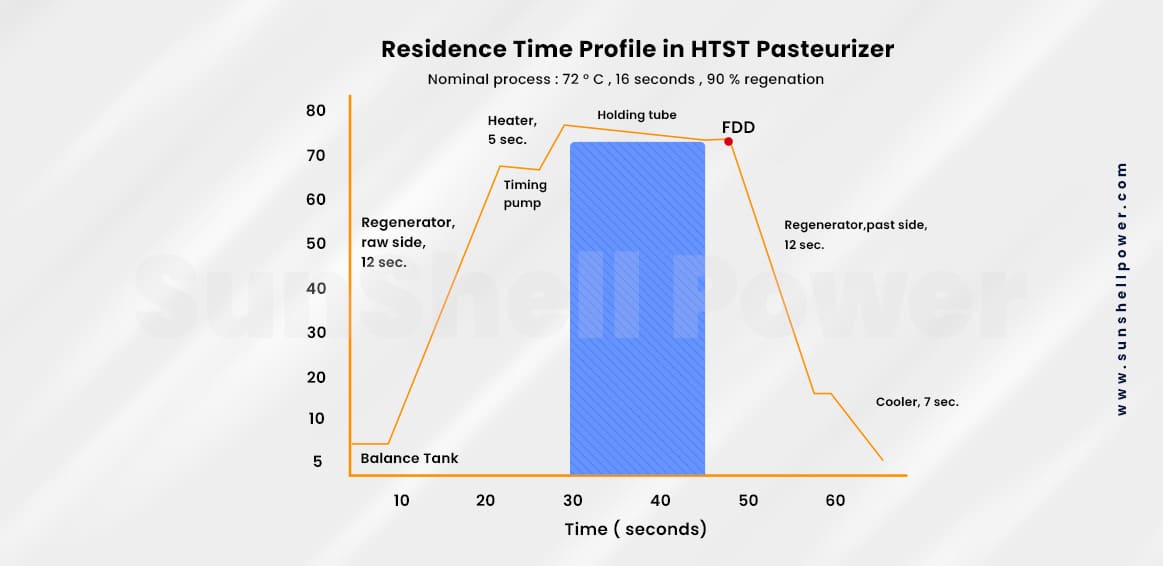
Become A Part of The Green Future
As the rest of the world moves toward net-zero emissions, India has set a net-zero objective for the year 2070. The government is providing numerous programmes and policies for solar systems.
Recently in the month of March, 2022 , Milky Mist Dairy commissioned a 7MW solar plant in their Kavilipalayam village, Tamil Nadu manufacturing unit.
A Chennai based dairy company Hatsun Agro Products has declared to install 1kW plants in over 8000 milk banks, situated over multiple villages across Tamil Nadu.
Enquire Now
